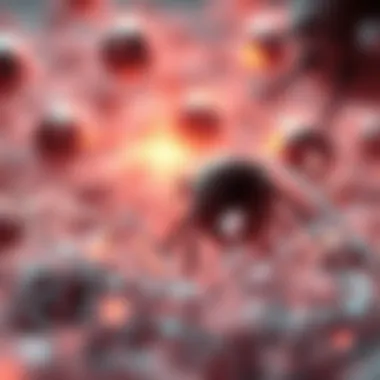Invasion Migration Assay: Insights and Applications


Intro
The field of invasion migration assays has gained traction in recent years, capturing the attention of those interested in cellular dynamics. These assays are not just technical exercises; they offer a window into understanding how cells navigate their environment, revealing critical insights important for researchers tackling a plethora of biological questions.
Invasion migration assays serve as powerful tools in laboratory settings, enabling the exploration of cellular behaviors related to movement, invasion, and migration. They can illuminate the mechanisms through which cells interact with their surroundings, which is crucial for fields like cancer research, immunology, and developmental biology. Whether it's a tumor cell traveling to spread cancer or immune cells assembling to fend off pathogens, these processes are fundamental to health and disease.
Overview of Research Topic
Brief Background and Context
Invasion migration assays trace back to early studies of cellular behavior, where researchers sought to understand not just how cells move but why they do so in certain situations. Historically, these assays were primarily focused on cancer studies, where the spread of cancerous cells was a significant concern. As knowledge expanded, the scope included other crucial areas like the immune response and tissue development.
Importance in Current Scientific Landscape
Today, the relevance of invasion migration assays spans multiple domains of biology. With cancer rates on the rise, understanding the invasive behavior of tumor cells has never been more critical. Furthermore, the role of these assays extends into immunological studies, highlighting how immune cells migrate to infection sites, as well as in developmental biology where they help explain how tissues form and organs develop.
In essence, invasion migration assays are more than mere experimental techniques; they are vital in unmasking the intricacies of cellular interactions and behaviors in both normal and diseased states. This exploration of their methodologies and applications in the following sections will empower students, researchers, and professionals to leverage this knowledge effectively.
Understanding Invasion Migration Assays
Invasion migration assays serve as a critical lens through which the behaviors of cells can be scrutinized, especially within the context of health and disease. This section seeks to illuminate the significance of these assays in both research and clinical settings, guiding students and professionals alike to grasp their underlying principles and methodologies. The capabilities of these assays extend beyond mere observation; they reveal the intricacies of cellular dynamics, providing insights into processes that range from wound healing to cancer metastasis.
The essence of this exploration lies in understanding how cells traverse different environments. In clinical research, the knowledge gained from invasion assays can shape therapeutic approaches, enhance drug development, and inform treatment strategies. For instance, when studying cancer metastasis, it becomes paramount to comprehend how cancer cells migrate from primary tumors to distant sites. Understanding these pathways is a cornerstone of effective oncology, leading to innovations in treatment and management.
Investing time and effort into mastering invasion migration assays is not just an academic exercise; it represents a vital step towards unraveling the complexities of cellular movement and interaction, propelling the health sciences forward.
Definition and Purpose
Invasion migration assays are experimental techniques designed to assess how cells move through matrigel or other extracellular matrix components. The primary aim of these assays is to simulate the conditions under which cells would navigate in physiological contexts, such as during tissue repair or the spread of cancer cell.
These assays measure several key factors: the rate of migration, the pathways taken by the cells, and the ability of cells to invade through barriers. The data produced can elucidate various cellular behaviors, such as motility, adhesion, and the response to chemotactic signals. This can highlight not just how cells move, but the efficacy of drugs that may inhibit or promote migration, thus serving as a crucial tool for drug development.
In summary, the purpose is twofold: to mimic real biological situations and to analyze how cells respond to different stimuli—all contributing to the synthesis of our understanding of cellular dynamics.
Historical Context
The roots of invasion migration assays can be traced back to early cellular biology studies, where the primary focus was understanding cellular behavior in isolated environments. However, these methodologies have transformed over the decades with advancements in technology and materials. Initially, the examination of cellular movement began with rudimentary techniques, but as scientists detected the limitations of static assays, a shift towards more dynamic environments commenced.
By the 1980s, the introduction of significant assay formats, such as Transwell assays, laid the groundwork for modern methodologies. Researchers began to appreciate the need for replicating the complex in vivo conditions in vitro. The emergence of matrigel invasion assays in the 1990s further propelled this experimentation, providing a gel-like matrix that better represented the extracellular environment.
Today, invasion migration assays encompass various sophisticated methods that take into account multiple physiological factors, such as three-dimensional cell culture models. The evolution of these assays reflects the ongoing quest in the scientific community to understand the principles of cellular movement and their implications for human health.
Mechanisms of Cellular Migration
Cellular migration is a fundamental process in biological systems and serves as a key player in a variety of physiological and pathological contexts. Understanding the mechanisms that drive cellular movement is crucial for interpreting how cells interact with their environment and how they respond to signals. This section dives into the intricate details behind cellular migration, exploring how cells adhere to surfaces, rearrange their cytoskeletal components, and engage in chemical signaling. These elements collectively contribute to our understanding of migration assays, especially in the context of disease modeling and treatment strategies.
Cell Adhesion Dynamics
Cell adhesion is often the first step in cellular migration, acting as the foundation upon which movement is constructed. Adhesion molecules, like integrins and cadherins, enable cells to attach to their extracellular matrix (ECM) or to other cells. This attachment is not a mere grip; it’s a dynamic partnership characterized by strengthening and weakening interactions as cells move.
Factors that influence cell adhesion include:
- Extracellular Matrix Composition: Different ECM proteins can either promote or inhibit migration. For instance, fibronectin is known to enhance migration, while collagen may have more complex effects depending on its structural arrangement.
- Biochemical Signals: Various growth factors and signaling molecules can modulate adhesion properties by triggering intracellular pathways that affect the expression of adhesion molecules.
- Mechanical Properties of the ECM: Stiffness and elasticity play critical roles in how effectively cells can bind to their surroundings. Cells tend to migrate more efficiently on softer substrates, which mimics physiological conditions.
Invasion migration assays often leverage variations in cell adhesion dynamics, allowing researchers to dissect how changes in ECM composition or cell signaling affect motility, a crucial insight for cancer metastasis studies.
Cytoskeletal Rearrangement
The cytoskeleton, a complex network of fibers within the cell, is integral to the mechanics of migration. Comprised primarily of actin filaments and microtubules, the cytoskeleton is the scaffolding that provides structural support while facilitating movement. Remodeling of the cytoskeletal elements is a finely-tuned process crucial for cell integrity during migration.


Several aspects of cytoskeletal rearrangement include:
- Actin Polymerization: Actin monomers rapidly assemble into chains, pushing the membrane forward. This process is powered by ATP, and its regulation is essential for directional movement.
- Myoisin Interaction: Myoisis II uses ATP to walk along actin filaments, facilitating contraction of the cell rear while the front extends, a coordinated event necessary for effective migration.
- Microtubule Dynamics: These structures help stabilize cell shape and assist with cargo transport to the plasma membrane, ensuring essential components are in place for migration.
The balance between cytoskeletal assembly and disassembly allows for adaptability, enabling cells to respond promptly to environmental cues. In invasion assays, observing how cells change their cytoskeletal structure provides critical insights into how invasive behaviors are regulated, particularly in cancer research.
Chemical Signaling Pathways
Cellular migration does not occur in isolation; it’s heavily influenced by a plethora of biochemical signals that dictate the direction and intensity of movement. Chemical signaling pathways enable cells to communicate with their environment and make timely decisions about migration based on external stimuli or internal physiological needs.
Key components of chemical signaling pathways include:
- Chemokines and Growth Factors: Substances like transforming growth factor-beta (TGF-β) and epidermal growth factor (EGF) can initiate complex signaling cascades that promote migration by enhancing cell motility attributes.
- Signal Transduction: Pathways such as the Rho family of GTPases (including Rho, Rac, and Cdc42) are pivotal in regulating cytoskeletal dynamics, linking extracellular signals to structural changes within the cell.
- Integrations of Signals: Cells often integrate multiple signals to tailor their migratory response, making it a multi-layered decision process influenced by myriad factors.
Understanding these chemical interactions is vital in developing more effective therapeutic approaches, especially in treating diseases characterized by unregulated cellular migration, such as cancer metastasis.
In summary, the mechanisms of cellular migration are complex and multifaceted, involving intricate interplay between adhesion, cytoskeletal dynamics, and chemical signaling. This knowledge underpins the principles of invasion migration assays, providing deeper insights into cellular behaviors that are crucial for both health and disease.
By dissecting these mechanisms, researchers pave the way for potential advancements in therapeutic strategies targeting various diseases, highlighting the relevance of invasion migration assays across a spectrum of biological research.
Types of Invasion Migration Assays
The exploration of invasion migration assays reveals a rich tapestry of methodologies designed to elucidate cellular behaviors in various biological contexts. Understanding the types of invasion migration assays is crucial, as each approach offers unique insights into the mechanisms driving cell movement, particularly in the realms of cancer research, immunology, and developmental biology. The choice of assay directly influences the outcomes of studies and can shed light on the complexities of cellular interaction with their environment. This section will explore four prevalent types of assays, highlighting their importance, benefits, and relevant considerations.
Transwell Assays
The Transwell assay, a classic in the field, is a favored technique owing to its simplicity and adaptability. It involves the use of a chamber separated by a permeable membrane, allowing cells to migrate from one side to the other. This setup mimics the in vivo environment, making it especially useful in studying the migration of cancer cells toward chemokines or growth factors.
One significant aspect of Transwell assays is their ability to quantitatively measure migration under various conditions, providing a window into the physiological and pathological processes at play. Researchers often find themselves employing this assay to assess the effects of different substances, ranging from pharmaceutical compounds to extracellular matrix components, on cell mobility.
"Transwell assays have become a staple in cancer research, offering insights that traditional methods simply cannot capture."
Pros of using Transwell assays include ease of use and reproducibility. However, it's essential to keep in mind that this assay has limitations. The two-dimensional environment may not fully capture the complexities of cellular behavior as seen in three-dimensional contexts. Researchers should, therefore, be cautious when extrapolating results from Transwell setups directly to in vivo scenarios.
Wound Healing Assays
Wound healing assays, or scratch assays, provide a unique look into cellular migration and proliferation. In this method, a "wound" is artificially created in a confluent layer of cells, and researchers observe how quickly the cells migrate to close the gap. This dynamic process reflects a multitude of biological responses, including migration, proliferation, and cell-cell interactions.
Unlike some other assays, wound healing techniques incorporate a form of cellular competition, creating a natural environment where cells must navigate toward one another. The simplicity of the wound healing assay lies in its setup and execution. Yet, it unravels some intricate behaviors - especially in studies of cancer metastasis. By analyzing the speed and strategy of closure, insights into how tumor cells invade surrounding tissues can be gathered.
However, researchers must be aware of endogenous factors that could influence migration, such as cell density or local environmental conditions. Therefore, controlling these variables is important to ensure robust and interpretable results in wound healing studies.
Matrigel Invasion Assays
When it comes to replicating the extracellular matrix, Matrigel invasion assays stand out as a powerful option. Matrigel, a gelatinous protein mixture, simulates the in vivo extracellular matrix environment, creating an opportunity for researchers to study how cells invade through a fibrous structure. This assay is particularly beneficial for examining the invasive potential of cancer cells.
Cells are placed on top of a Matrigel layer and allowed to migrate through it toward a nutrient source. The results provide a closer approximation of actual tumor invasion compared to simpler assays. The ability to manipulate the matrix composition also allows researchers to explore how different factors affect cell behavior in a more physiologically relevant context.
However, using Matrigel is not without its challenges. The variability in its composition can lead to inconsistent results, so meticulous preparation and handling are paramount. Additionally, this assay may be more labor-intensive than others, requiring precise temperature control and timing.
3D Cell Culture Models
3D cell culture models represent a significant step forward in assessing invasion migration. Unlike the traditional 2D cultures, these models mimic the complex architecture of tissues, allowing for more realistic interactions between cells and their microenvironment. They are especially notable in cancer research for studying the heterogeneous nature of tumors and the intricate dynamics of invasion.
In these models, cells can aggregate and form spheroids, emulating how they would behave in a living organism. This spatial arrangement not only impacts migration but also influences gene expression, drug response, and overall cellular behavior. As a result, 3D cultures enhance the translational potential of research findings.
While the insights gained from 3D culture systems are profound, they are also more demanding in terms of resources and expertise required to create and maintain these models. Moreover, they can vary widely based on the specific setup used, so consistency is critical for accurate data interpretation.
In summary, the range of invasion migration assays — Transwell, wound healing, Matrigel, and 3D cell culture models — each has its own strengths and weaknesses. Selecting the right assay for a specific research question depends on various factors, including the biological context, the level of complexity desired, and the resources available. Collectively, these assays form a vital part of advancing our understanding of cell migration and invasion, with implications stretching from basic research to therapeutic development.
Experimental Design


Experimental design plays a fundamental role in the execution of invasion migration assays. It refers to the systematic planning of experiments to ensure that outcomes can be interpreted accurately and reliably. A well-thought-out experimental design not only increases the validity of the results but also enhances the reproducibility of the findings, which is crucial in a scientific environment. Let's delve into some specific elements that significantly impact the integrity of the results drawn from invasion migration assays, unpacking the importance of choosing appropriate assays, controlling variables, and addressing reproducibility considerations.
Choosing the Appropriate Assay
Selecting the right assay is pivotal in drawing valid conclusions from experiments centered around cellular migration and invasion. Different assays cater to various cellular behaviors, and each has its own strengths and limitations. For instance, Transwell assays are great for studying migration through membranes, while Matrigel invasions assays mimic extracellular matrix conditions, providing insights on how cells infiltrate tissues.
When deciding on an assay, consider:
- Objective of the Study: What specific cellular behavior are you investigating? Each assay can illuminate different aspects of migration.
- Cell Type: Some assays work better with certain cell types. Understanding the biology of your cells is key.
- Relevance to Physiological Conditions: Choose an assay that best simulates natural circumstances. For instance, 3D cell culture models can offer a more realistic environment compared to traditional 2D cultures.
Making an informed decision here lays the groundwork for further experiments, influencing how data will be interpreted.
Controlling Variables
In invasion migration assays, controlling variables is crucial for eliminating extraneous factors that could skew results. Numerous variables can affect the migration process, such as:
- Growth Factors: The presence of specific molecules that can either promote or inhibit cell movement.
- Time Duration: The length of incubation must be standardized to ensure comparability of data across different trials.
- Temperature and CO2 Concentration: Environmental conditions need to be consistent since biological responses can change significantly with even slight fluctuations.
By maintaining consistent control over these variables, researchers can minimize noise in their data, making it easier to assess the true effects of the experimental conditions on cellular migration.
Reproducibility Considerations
Reproducibility is a cornerstone of scientific research, ensuring that findings can be verified and built upon by other scientists. Factors influencing reproducibility extend beyond just technical execution; they often intertwine with the design and analysis of the experiments conducted. Key considerations include:
- Detailed Protocols: Documenting step-by-step methods precisely allows others to replicate your study without ambiguity. Provide clear instructions on assay conditions and steps taken during the experiment.
- Proper Number of Replicates: Running sufficient biological replicates strengthens statistical significance and enhances data reliability. One should aim for a robust sample size to account for variances.
- Transparent Data Sharing: Open access to statistical methods and raw data supports scrutiny and validation by peers, fostering an environment of trustworthiness around findings.
In summary, a focused approach to experimental design benefits not just the conducting researcher but the broader scientific community as well. Providing clarity about assumptions and methodologies facilitates understanding and contributes to a reliable body of knowledge in the field of invasion migration assays.
"In the realm of biology, clarity in experimental design resonates much like a compass guiding a traveler—without it, one may easily lose their way in the wilderness of data."
For additional insights, explore resources such as National Institutes of Health and Nature for valuable guidance on best practices in assay design and implementation.
Applications of Invasion Migration Assays
Invasion migration assays serve as crucial tools for understanding various biological processes and disease mechanisms. By shedding light on cellular behavior, these assays provide significant insights that can inform both basic research and clinical applications. Understanding the applications of invasion migration assays in different fields underscores their relevance and impact in advancing scientific knowledge.
Cancer Metastasis Research
One of the most notable applications of invasion migration assays is in cancer metastasis research. When cancer cells spread from their original site to other parts of the body, the processes involved can be complex and multifaceted. Invasion migration assays are indispensable for studying these processes because they allow researchers to mimic and measure the conditions under which metastasis occurs.
Here are some specific benefits this offers:
- Modeling Tumor Behavior: Assays can help replicate the tumor microenvironment, which is essential for understanding how cancer cells invade surrounding tissues.
- Drug Testing: By subjecting cancer cells to various therapeutic compounds, researchers can evaluate how well these drugs inhibit cell migration and invasion, informing treatment strategies.
- Biomarker Discovery: The data garnered from these assays can help identify biomarkers that predict metastatic potential, thus aiding in early diagnosis and targeted therapy.
In sum, through methods like Matrigel invasion assays and Transwell assays, scientists can peel back the layers of cancer biology and devise new avenues for treatment.
Developmental Biology Studies
In addition to oncology, invasion migration assays present a wealth of information in developmental biology studies. These assays help elucidate how cells communicate and interact during development. Migration is a critical biological process, as tissues and organs form through a series of well-orchestrated cellular movements.
- Understanding Cell Movement: Researchers utilize assays to observe how stem cells differentiate and migrate to specific tissues, thus enhancing our understanding of developmental pathways.
- Embryogenesis Insights: Investigating how cells move during early embryonic development sheds light on congenital anomalies and can potentially identify preventative measures.
- Tissue Engineering: Specific assays can also contribute to the field of tissue engineering by providing data on how cells can be guided to grow and organize into functional tissues.
These investigations exemplify how invasion assays bridge the gap between cellular mechanics and broader biological phenomena, offering potential for advancements in regenerative medicine and developmental therapies.
Immune Response Investigations
Immune response investigations also benefit significantly from invasion migration assays. The immune system relies heavily on the mobility of various immune cells to respond to infections and diseases. Studying how immune cells migrate can provide crucial insights into immune function and efficacy.
Key elements of this application include:
- Cell Migration Dynamics: By observing the behavior of immune cells in response to pathogens or tumor cells, researchers can learn how effectively the immune system is functioning.
- Therapeutic Development: Understanding cell migration plays a significant role in designing therapies for autoimmune diseases, where immune cells can wrongly target the body’s cells.
- Vaccine Efficacy: Additionally, these assays can help gauge the efficacy of vaccines by assessing how well immune cells travel and function post-vaccination.


"Invasion migration assays are not just experimental techniques; they are gateways to understanding life at a cellular level, revealing the intricate dance of cells in health and disease."
Challenges and Limitations
In the realm of invasion migration assays, understanding the challenges and limitations is crucial for accurately interpreting and applying findings. Even as these methodologies provide significant insights into cellular behavior, their efficacy can be hindered by various factors. Recognizing these pitfalls helps improve experimental design and data analysis, ultimately enhancing the relevance of research in biological fields.
Technical Variability
One of the foremost challenges in invasion migration assays is technical variability. This occurs when results fluctuate due to differences in assay performance. For instance, subtle variations in how cells are prepared, the choice of substrates, or even the environmental conditions can dramatically change outcomes. Such inconsistencies may skew results, making it hard to draw reliable conclusions.
Researchers must pay keen attention to details, such as:
- Cell source: Different cell lines, even those from the same parent cell, may exhibit varied migration rates or invasion capabilities.
- Assay conditions: Factors like temperature, humidity, and CO2 concentrations can affect cellular behavior.
- Reagents used: Variations in the purity or concentration of growth factors may lead to unexpected results.
Controlling for these elements is paramount. It’s essential that researchers develop standardized protocols to minimize variability and improve repeatability. Effective training and comprehensive documentation can also serve as buffers against unpredictable factors.
Biological Complexity
Cellular migration and invasion are not straightforward processes; they are influenced by a complex interplay of biological factors. This biological complexity poses an inherent challenge when interpreting results from migration assays. Cells do not operate in isolation; they respond to a myriad of signals from their microenvironment. This may include communication between adjacent cells, interactions with extracellular matrices, and diffusion of soluble factors.
This complexity can manifest in several ways:
- Heterogeneity of cell populations: Even a slight difference within a single cell line can lead to varying migratory behavior depending on the genetic background or epigenetic modifications.
- Environmental components: The presence of signaling molecules or physical barriers in the assay can alter cellular responses. For example, varying concentrations of chemokines can dramatically change migration patterns.
- Temporal dynamics: Cells may behave differently at various stages of assay development. Time points chosen for analysis are critical; missing the right one could mask essential insights.
To mitigate these effects, employing multi-faceted approaches—like live-cell imaging and high-throughput screening—can provide a clearer picture of cellular dynamics.
Data Interpretation Difficulties
The interpretation of data from invasion migration assays is fraught with difficulties that can lead to misrepresentation of findings. Many researchers face the challenge of sifting through large volumes of data while understanding the context in which it fits. The sheer variety of assays available can lead to confusion about which parameters are most telling.
Several common pitfalls include:
- Misleading metrics: Relying on single metrics, like the number of cells that crawl through a membrane, can ignore crucial behavioral aspects such as cell morphology and spatial distribution.
- Overlooking control comparisons: Without proper controls, it’s easy to draw incorrect conclusions about treatment effects. For instance, failing to compare against untreated populations might inflate the presumed effect of a novel drug.
- Statistical analysis: Inadequate statistical methods can obscure true relationships between variables or lead to erroneous claims of significance.
Researchers should strive for a thorough and systematic approach to data evaluation, ensure the use of appropriate statistical methods, and be wary of overstepping claims drawn from partial findings.
“In science, it's not about having a clear answer; it's often about recognizing the limitations of your knowledge.”
Navigating the challenges and limitations in invasion migration assays demands careful planning and implementation, alongside a commitment to rigorous scientific standards. Acknowledging these intricacies will help researchers enhance the reliability of their findings and ultimately further the understanding of cell movement in health and disease.
Future Directions
The study of invasion migration assays is at a fascinating juncture as advancements in technology and a deeper understanding of biological processes pave the way for new possibilities. The importance of examining future directions in this arena cannot be overstated, as it holds significant implications for cancer research, developmental biology, and immunology.
In exploring future avenues, several key aspects come to the fore. These include the incorporation of emerging technologies, the fusion with genomic studies, and the potential therapeutic applications that these assays can facilitate. Each of these elements is crucial in enhancing our comprehension of cellular behavior, ultimately leading to innovative approaches in treatment and research.
Emerging Technologies
As science presses onward, novel technologies are revolutionizing how we approach invasion migration assays. One of the most exciting developments is the application of microfluidics. This technology allows scientists to simulate physiological conditions more accurately by manipulating fluid flow at a microscale. Such detail enables deeper insights into how cells migrate, adapt, and interact within their environments.
Additionally, advancements in imaging techniques, such as live-cell imaging, provide a fresh perspective on cellular dynamics. Real-time observation of cell behaviors during migration allows researchers to uncover nuances previously hidden from standard methodologies. Techniques like CRISPR-based tools are also gaining traction, enabling targeted genetic modifications that can elucidate the role of specific genes in the migration process. Overall, combining these technologies not only enhances experimental fidelity but also widens the spectrum of research possibilities.
Integration with Genomic Studies
The synthesis of invasion migration assays with genomic studies represents a formidable stride toward comprehensive understanding. By integrating these two domains, researchers can pinpoint the genetic underpinnings that dictate cellular migration patterns. This integration can reveal how certain genes or mutations influence invasiveness in cancer cells, offering clues into new therapeutic strategies.
For instance, single-cell RNA sequencing can be employed alongside invasion assays to identify gene expression profiles in migrating cells. Such profiles can elucidate the biological pathways that are active during invasion, fostering the development of targeted therapies that aim to disrupt these pathways. This multidimensional approach not only enhances the accuracy of translational research but also reinforces the biology behind the disease processes.
Potential for Therapeutic Applications
Looking further ahead, the therapeutic potential sparked from insights gained through invasion migration assays is immense. A better grasp of how cells navigate their environments can lead to the formulation of innovative interventions. In particular, we can envisage the use of compounds that specifically inhibit migratory pathways in cancer cells, potentially staving off metastasis.
Moreover, understanding the mechanisms behind cell migration could also lend insights into regenerative medicine. For example, manipulating the migration capabilities of stem cells could improve tissue repair strategies.
The convergence of these future directions paints a compelling picture. By embracing technological innovations, harmonizing with genomic research, and pursuing their therapeutic potential, we can significantly enhance our understanding of invasion migration. This journey goes beyond mere academic interest; it holds the promise of translating findings into practical applications that can improve human health on multiple fronts.
In the world of biological research, the future is not just about asking questions; it’s about integrating answers across various domains for a holistic understanding.



